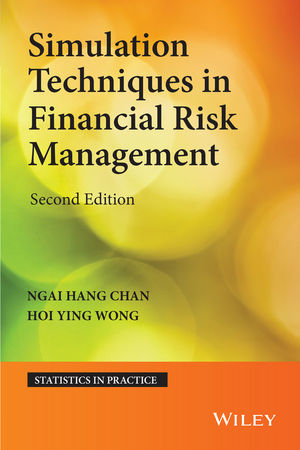
Simulation Techniques in Financial Risk Management
John Wiley & Sons Inc (Verlag)
978-1-118-73581-7 (ISBN)
- Titel ist leider vergriffen;
keine Neuauflage - Artikel merken
Praise for the First Edition a nice, self-contained introduction to simulation and computational techniques in finance Mathematical Reviews Simulation Techniques in Financial Risk Management, Second Edition takes a unique approach to the field of simulations by focusing on techniques necessary in the fields of finance and risk management. Thoroughly updated, the new edition expands on several key topics in these areas and presents many of the recent innovations in simulations and risk management, such as advanced option pricing models beyond the Black Scholes paradigm, interest rate models, MCMC methods including stochastic volatility models simulations, model assets and model-free properties, jump diffusion, and state space modeling.
The Second Edition also features: * Updates to primary software used throughout the book, Microsoft Office(R) Excel(R) VBA * New topical coverage on multiple assets, model-free properties, and related models * More than 300 exercises at the end of each chapter, with select answers in the appendix, to help readers apply new concepts and test their understanding * Extensive use of examples to illustrate how to use simulation techniques in risk management * Practical case studies, such as the pricing of exotic options; simulations of Greeks in hedging; and the use of Bayesian ideas to assess the impact of jumps, so readers can reproduce the results of the studies * A related website with additional solutions to problems within the book as well as Excel VBA and S-Plus computer code for many of the examples within the book Simulation Techniques in Financial Risk Management, Second Edition is an invaluable resource for risk managers in the financial and actuarial industries as well as a useful reference for readers interested in learning how to better gauge risk and make more informed decisions.
The book is also ideal for upper-undergraduate and graduate-level courses in simulation and risk management.
Ngai Hang Chan, PhD, is Choh-Min Li Chair Professor of Statistics of the Department of Statistics at The Chinese University of Hong Kong. An elected Fellow of the Institute of Mathematical Statistics and the American Statistical Association, Professor Chan is also the co-editor and associate editor of 8 journals and author of Time Series: Applications to Finance with R and S-Plus, Second Edition and Handbook of Financial Risk Management: Simulations and Case Studies, both also published by Wiley. His research interests include statistical finance, risk management, time series, econometrics, and stochastic modeling. Hoi-Ying Wong, PhD, is Professor in the Risk Management Science Program of the Department of Statistics at The Chinese University of Hong Kong. Professor Wong is also associate editor of one journal and the author of Handbook of Financial Risk Management: Simulations and Case Studies, also published by Wiley. His research interests include derivatives pricing, interest rate modeling, financial risk management, and statistical finance.
List of Figures xi List of Tables xiii Preface xv 1 Preliminaries of VBA 1 1.1 Introduction 1 1.2 Basis Excel VBA 1 1.2.1 Developer Mode and Security Level 2 1.2.2 Visual Basic Editor 2 1.2.3 The Macro Recorder 5 1.2.4 Setting Up a Command Button 6 1.3 VBA Programming Fundamentals 8 1.3.1 Declaration of Variables 8 1.3.2 Types of Variables 8 1.3.3 Declaration of Multivariable 9 1.3.4 Declaration of Constants 9 1.3.5 Operators 9 1.3.6 User-Defined Data Types 10 1.3.7 Arrays and Matrices 11 1.3.8 Data Input and Output 12 1.3.9 Conditional Statements 12 1.3.10 Loops 13 1.3.11 Sub Procedures and Function Procedures 15 1.3.12 VBA s Built-In Functions 18 2 Basic Properties of Futures and Options 19 2.1 Introduction 19 2.1.1 Arbitrage and Hedging 19 2.1.2 Forward Contracts 20 2.1.3 Futures Contracts 23 2.2 Options 26 2.3 Exercises 31 3 Introduction to Simulation 35 3.1 Questions 35 3.2 Simulation 35 3.3 Examples 36 3.3.1 Quadrature 36 3.3.2 Monte Carlo 37 3.4 Stochastic Simulations 38 3.5 Exercises 40 4 Brownian Motions and Ito s Rule 41 4.1 Introduction 41 4.2 Wiener and Ito s Processes 41 4.3 Stock Price 46 4.4 Ito s Formula 47 4.5 Exercises 54 5 Black Scholes Model and Option Pricing 57 5.1 Introduction 57 5.2 One Period Binomial Model 58 5.3 The Black Scholes Merton Equation 61 5.4 Black Scholes Formula 67 5.5 Exercises 72 6 Generating Random Variables 75 6.1 Introduction 75 6.2 Random Numbers 75 6.3 Discrete Random Variables 76 6.4 Acceptance-Rejection Method 78 6.5 Continuous Random Variables 79 6.5.1 Inverse Transform 80 6.5.2 The Rejection Method 81 6.5.3 Multivariate Normal 83 6.6 Exercises 87 7 Standard Simulations in Risk Management 89 7.1 Introduction 89 7.2 Scenario Analysis 89 7.2.1 Value at Risk 91 7.2.2 Heavy-Tailed Distribution 92 7.2.3 Case Study: VaR of Dow Jones 94 7.3 Standard Monte Carlo 96 7.3.1 Mean, Variance, and Interval Estimation 97 7.3.2 Simulating Option Prices 99 7.3.3 Simulating Option Delta 102 7.4 Exercises 104 7.5 Appendix 105 8 Variance Reduction Techniques 107 8.1 Introduction 107 8.2 Antithetic Variables 107 8.3 Stratified Sampling 112 8.4 Control Variates 120 8.5 Importance Sampling 125 8.6 Exercises 131 9 Path Dependent Options 133 9.1 Introduction 133 9.2 Barrier Option 133 9.3 Lookback Option 135 9.4 Asian Option 136 9.5 American Option 138 9.5.1 Simulation: Least Squares Approach 138 9.5.2 Analyzing the Least Squares Approach 141 9.5.3 American Style Path Dependent Options 144 9.6 Greek Letters 145 9.7 Exercises 148 10 Multiasset Options 151 10.1 Introduction 151 10.2 Simulating European Multiasset Options 152 10.3 Case Study: On Estimating Basket Options 153 10.4 Dimension Reduction 155 10.5 Exercises 158 11 Interest Rate Models 161 11.1 Introduction 161 11.2 Discount Factor and Bond Prices 161 11.3 Stochastic Interest Rate Models and Their Simulations 165 11.4 Hull White Model 167 11.5 Fixed Income Derivatives Pricing 171 11.6 Exercises 174 12 Markov Chain Monte Carlo Methods 177 12.1 Introduction 177 12.2 Bayesian Inference 177 12.3 Simulating Posteriors 179 12.4 Markov Chain Monte Carlo 180 12.4.1 Gibbs Sampling 180 12.4.2 Case Study: The Effect of Jumps on Dow Jones 183 12.5 Metropolis Hastings Algorithm 188 12.6 Exercises 196 References 199 Index 203
| Reihe/Serie | Statistics in Practice |
|---|---|
| Verlagsort | New York |
| Sprache | englisch |
| Maße | 162 x 236 mm |
| Gewicht | 516 g |
| Themenwelt | Mathematik / Informatik ► Mathematik ► Angewandte Mathematik |
| Mathematik / Informatik ► Mathematik ► Wahrscheinlichkeit / Kombinatorik | |
| Wirtschaft ► Betriebswirtschaft / Management ► Finanzierung | |
| ISBN-10 | 1-118-73581-1 / 1118735811 |
| ISBN-13 | 978-1-118-73581-7 / 9781118735817 |
| Zustand | Neuware |
| Informationen gemäß Produktsicherheitsverordnung (GPSR) | |
| Haben Sie eine Frage zum Produkt? |
aus dem Bereich


